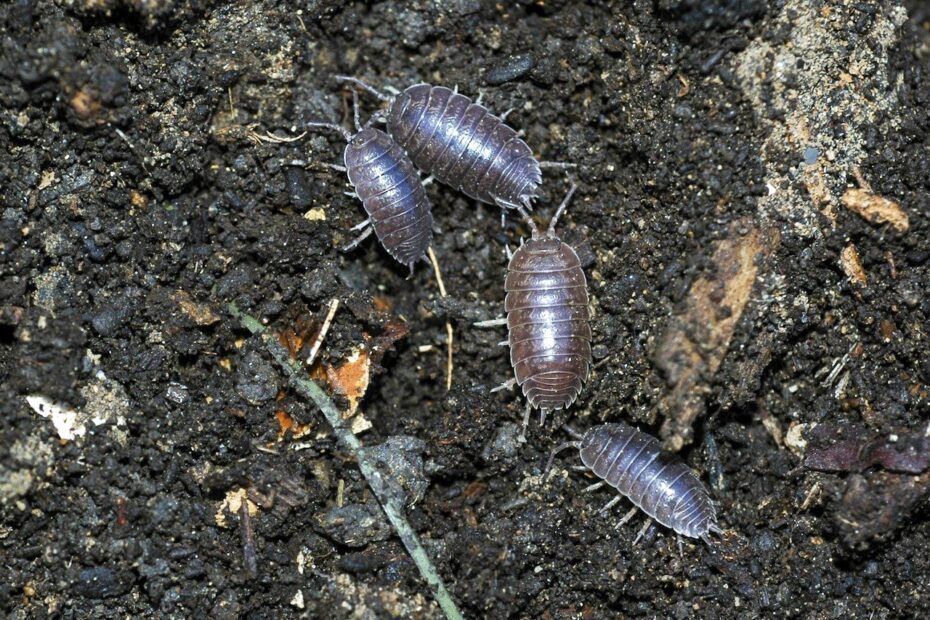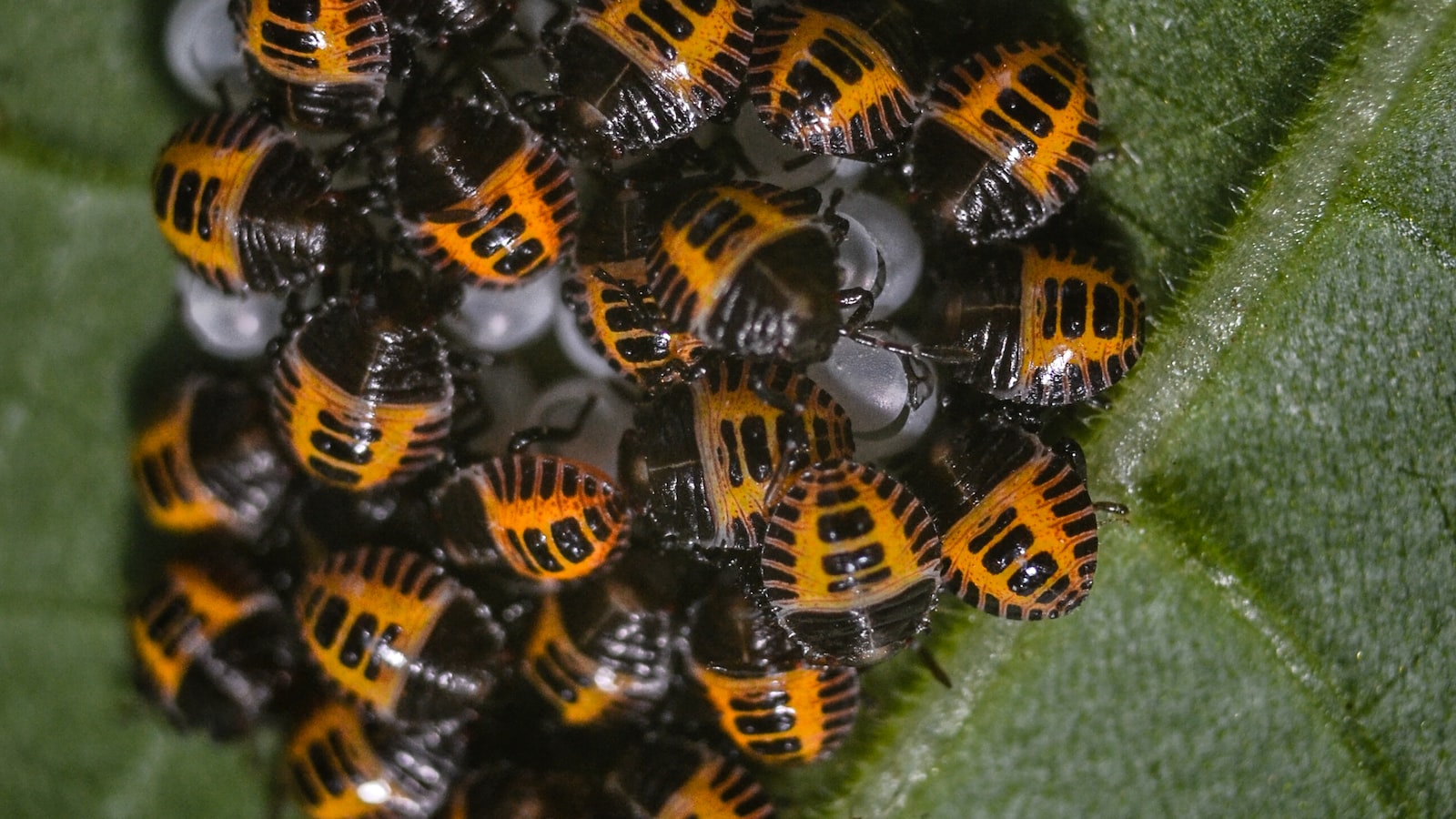
In the enchanting world of gardening, mulch serves as a magnificent veil that beautifies our beds, protects tender roots, and nurtures our plants with its organic charm. However, even the most picturesque garden can face pesky invaders, as insects gleefully seek refuge in this haven of nutrients and moisture. Fear not, dear green thumbs, for we have embarked on a quest to unveil the secrets of banishing bugs from your beloved mulch. From serene potions to cunning strategies, join us as we explore the ethereal realm of pest control, empowering you to reclaim your mulch with a touch of whimsical wisdom.

Understanding the Common Bugs Found in Mulch: Identifying the Culprits
Mulch is a popular landscaping material that not only enhances the aesthetic appeal of gardens but also helps in moisture retention and weed control. However, it is not uncommon to find pesky bugs invading your mulch, causing frustration and discomfort. To help you combat this problem effectively, we have compiled a list of common bugs found in mulch and ways to identify them.
1. Fungus Gnats – These tiny black flies are often seen buzzing around the mulch surface. To confirm their presence, check for larval activity in the soil beneath the mulch. Fungus gnats thrive in moist conditions, so be cautious if your mulch tends to retain excessive moisture.
2. Springtails – These minuscule arthropods are usually dark grey or black in color and can easily go unnoticed due to their size. However, if you carefully observe the surface of the mulch, you may spot them hopping around. Springtails thrive in damp environments, so ensure adequate drainage for your mulch.
3. Carpenter Ants – These large ants are commonly found nesting in wood mulch or decaying trees. Keep an eye out for sawdust-like material around the mulch, which might indicate their presence. Unlike termites, carpenter ants do not feed on wood, but they can still cause structural damage if their population increases significantly.
Now that you can identify some common culprits, you may wonder how to get rid of bugs in mulch. Here are a few features you can consider in your battle against these unwanted guests:
Loading... Seconds Left for
Miniature Orchid Terrarium Gallery!

| Features/Tips |
Description |
| Proper Mulch Depth |
Maintain a mulch layer of about 2-4 inches deep, as this helps deter bugs by improving airflow and reducing moisture retention. |
| Dry Mulch |
Allow the mulch to dry out between waterings to discourage bugs that thrive in moisture. Regularly check for signs of excessive moisture and adjust your watering accordingly. |
| Natural Bug Repellents |
Consider using natural bug repellents such as cedar mulch or essential oils like neem oil, peppermint oil, or garlic oil to deter bugs from infesting your mulch. This can help keep your garden bug-free without resorting to harmful pesticides. |
By understanding the common bugs found in mulch and implementing these tips, you can successfully mitigate the bug problem and enjoy a flourishing and pest-free garden.

Creating an Unattractive Environment for Bugs in Mulch: Smart Gardening Practices
When it comes to maintaining a bug-free garden, mulch can often be a double-edged sword. While it provides numerous benefits, such as moisture retention and weed suppression, it can also attract unwanted pests. But fear not, for there are smart gardening practices that can help create an unattractive environment for bugs in mulch.
Firstly, &#
x200C;consider using organic mulches like wood chips or shredded leaves, as they break down slowly and are less appealing to bugs compared to fresh mulch. Additionally, regularly turning and aerating the mulch will disturb any potential bug habitats and make it less inviting for them to settle. Furthermore, incorporating some natural bug repellents like dried mint, garlic, or citronella oils into the mulch can act as a deterrent without harming the environment.
| Features |
Tips |
| 1. Mulch thickness |
Make sure the mulch layer is no more than 2-3 inches thick to avoid creating a humid environment that attracts bugs. |
| 2. Weed control |
Keep the area around the mulch free from weeds, as they can provide shelter and breeding grounds for bugs. |
| 3. Proper drainage |
Ensure proper drainage in the garden to prevent water accumulation in the mulch, which can attract bugs. |

Natural and Effective Solutions to Control Bugs in Mulch: Earth-friendly Remedies
<p>
Looking for natural ways to get rid of those pesky bugs infiltrating your mulch? We've got you covered with some earth-friendly remedies that will keep your garden bug-free! No need for harmful chemicals or expensive pesticides. With just a few simple tricks, you can maintain a healthy and pest-free mulch bed right in your backyard!
</p>
<p>
Let Mother Nature do her work with these natural bug control methods:
<ul>
<li><b>Beneficial Insects:</b> Encourage ladybugs, lacewings, or praying mantises to make a home in your garden. These helpful predators will feast on the insects infesting your mulch, naturally keeping the population in check.</li>
<li><b>Essential Oil Sprays:</b> Mix a few drops of essential oils like peppermint, neem, or lavender with water in a spray bottle. Apply this fragrant solution to your mulch bed to repel bugs and add a refreshing aroma to your garden.</li>
<li><b>Garlic and Onion Barrier:</b> Create a protective barrier around your mulch by <a href="https://up-gardening.com/do-mice-eat-tomato-plants/" title="Do Mice Eat Tomato Plants">placing crushed garlic cloves</a> or diced onions. The strong smell will deter bugs, preventing them from infesting your beloved plants.</li>
<li><b>Diatomaceous Earth:</b> Sprinkle food-grade diatomaceous earth on top of your mulch. This natural powder works by dehydrating and eliminating bugs on contact while remaining safe for plants, pets, and people.</li>
</ul>
</p>
<table>
<tr>
<th>Features</th>
<th>Tips</th>
</tr>
<tr>
<td>Environmentally-friendly</td>
<td>Apply remedies regularly for optimal results</td>
</tr>
<tr>
<td>Natural bug control</td>
<td>Maintain proper mulch moisture to discourage pests</td>
</tr>
<tr>
<td>No harmful chemicals</td>
<td>Keep mulch well-maintained and regularly turn it to reduce bug habitat</td>
</tr>
</table>

One of the main challenges of using mulch in your garden is the risk of bug infestations. Nothing ruins the beauty of a well-maintained garden like a swarm of hungry pests. Fortunately, there are several maintenance tips and best practices you can follow to prevent future bug infestations in your mulch.
Tips for Preventing Bug Infestations in Mulch:
| #1 |
Regularly inspect your mulch for signs of bugs, such as visible pests, eggs, or larvae. |
| #2 |
Remove any infested mulch immediately to prevent the bugs from spreading. |
| #3 |
Consider using mulch made from pest-resistant materials, like cedar or cypress, to deter bugs. |
Best Practices to Keep Bugs at Bay:
- Regularly rake and turn your mulch to prevent the buildup of moisture, which can attract bugs.
- Avoid piling mulch too high against the base of trees or plants, as it creates a cozy habitat for insects.
- Maintain⁣ good garden hygiene by removing any fallen leaves or debris, which can also harbor pests.
With these proactive maintenance tips and best practices, you can enjoy the benefits of mulch without worrying about unwanted bug infestations in your garden. Happy gardening!
Frequently Asked Questions
Q: Are bugs bug-ging you out in your mulch? Fear not, we’ve got the scoop on banishing those pesky critters. Check out our creative Q&A below to bid farewell to bug invasion in your garden!
Q: Help! My
mulch is infested with bugs. How can I get rid of them?
A: Fear not, bug-battered gardener! There are a few ways to reclaim your mulch from these tiny invaders. Firstly, you can try sprinkling diatomaceous earth on the affected areas. As if conducting a mystical ritual, the earth’s sharp particles will naturally ward off bugs, without harming your plants. Another option is to introduce beneficial nematodes into your mulch. These microscopic warriors feast on insect larvae, effectively eradicating the source of your bug problem. Lastly, if you fancy a more hands-on approach, grab a pair of gardening gloves and inspect your mulch. Hand-pick and dispose of any visible bugs you find – a simple but satisfying solution!
Q: I want to avoid using harmful chemicals to solve my mulch bug conundrum. Any organic remedies you’d recommend?
A:
Absolutely! Embrace the power of nature and give those bugs a run for their money. Consider utilizing essential oils to deter these pesky freeloaders. Peppermint oil, for instance, serves as an excellent natural repellent. Dilute a few drops with water and spray it on your mulch – bugs will promptly vacate the premises, without harming your plants. If you prefer a more aromatic approach, spread a layer of cedar chips on top of your mulch. Bugs not only despise the scent, but the chips also serve as a visually pleasing touch to your garden. Mother Nature’s bug-banishing army is here to help!
Q: Can mulch type play a role in attracting or repelling bugs?
A: Indeed, it can! Just like music preference divides us humans, bugs also have their distinct preferences. If you’re facing a bug invasion, you may want to switch up your mulch selection. For instance, certain wood-based mulches like cedar or cypress tend to repel insects due to their natural oils. Bugs simply can’t stand the scent! On the other hand, mulches made from decomposed leaves or organic matter might be an open invitation to creepy crawlies. So, when selecting your mulch, take into account not just aesthetic appeal, but also the bug-repellent potential. Give your garden a bug-deterring makeover and say goodbye to their unwelcome presence!
Note: While
the recommendations provided in this creative Q&A may be effective for managing bugs in mulch, it’s always essential to research and ensure specific solutions are suitable for your garden and bug infestation severity. As we conclude our journey through the world of mulch bug battles, we hope you now feel armed with an arsenal of knowledge to combat those pesky critters lurking within your garden sanctuary. With a little perseverance and some clever tricks up your gardening gloves, bidding farewell to bothersome bugs in your mulch need no longer be an arduous task.
Remember, dear garden enthusiast, prevention is key! Remaining vigilant and opting for insect-resistant mulch varieties can serve as a fortress against unwelcome insect infiltrators. Take the time to assess your beloved green space regularly, addressing any signs of infestation promptly.
Should bugs still dare to march into your mulch haven, fret not! Armed with environmentally friendly remedies such as diatomaceous earth and beneficial nematodes, you possess the power to restore equilibrium within your garden once more. These natural warriors shall vanquish the invaders while keeping the delicate balance of nature intact.
Embrace the
camaraderie of ladybugs and lacewings, those honorable warriors against aphids and mealybugs. Provide them with shelter and a warm welcome, watching in awe as they turn the tide of battle in your favor. Ensure their provisions are plentiful, for in their delicate yet voracious appetites lie the secrets to a bug-free mulching utopia.
With patience, care, and an unwavering commitment to the well-being of your earthly oasis, you shall emerge victorious in this enthralling crusade against the bugs in your mulch. In time, your garden shall regain its vibrancy, thriving under your watchful eye and diligent efforts.
As the sun begins to set on our bug-busting expedition, we encourage you to embrace this newfound knowledge and craft your own unique gardening legacy. Share your wisdom with fellow green thumbs, for fostering a community of resilient gardeners shall ensure that the bugs remain at bay. Together, we can transform our little patches of earth into resilient havens, where colorful blooms sway freely, and bugs are but a memory.
Hello! I'm Jessica Owen, an avid gardener and proud contributor to Up-Gardening.com. Gardening is my passion, and I'm delighted to share my green-thumb experiences with you. From planting tips to nurturing blooms, I'm here to help you cultivate your own slice of paradise. Let's grow together in the garden!
Latest posts by Jessica Owen
(see all)v>
<
!-- CONTENT END 1 -->





